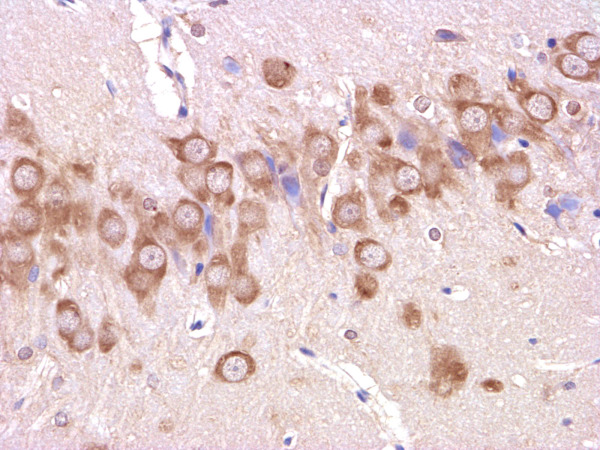APP antibody [C2C3], C-term
GTX101336
ApplicationsImmunoFluorescence, Western Blot, ImmunoCytoChemistry, ImmunoHistoChemistry, ImmunoHistoChemistry Frozen, ImmunoHistoChemistry Paraffin
Product group Antibodies
ReactivityHuman, Mouse, Rat
TargetAPP
Overview
- SupplierGeneTex
- Product NameAPP antibody [C2C3], C-term
- Delivery Days Customer9
- Application Supplier NoteWB: 1:500-1:3000. ICC/IF: 1:100-1:1000. IHC-P: 1:100-1:1000. *Optimal dilutions/concentrations should be determined by the researcher.Not tested in other applications.
- ApplicationsImmunoFluorescence, Western Blot, ImmunoCytoChemistry, ImmunoHistoChemistry, ImmunoHistoChemistry Frozen, ImmunoHistoChemistry Paraffin
- CertificationResearch Use Only
- ClonalityPolyclonal
- Concentration0.2 mg/ml
- ConjugateUnconjugated
- Gene ID351
- Target nameAPP
- Target descriptionamyloid beta precursor protein
- Target synonymsAAA, ABETA, ABPP, AD1, APPI, CTFgamma, CVAP, PN-II, PN2, alpha-sAPP, preA4, amyloid-beta precursor protein, alzheimer disease amyloid A4 protein homolog, alzheimer disease amyloid protein, amyloid beta (A4) precursor protein, amyloid beta A4 protein, amyloid precursor protein, beta-amyloid peptide, beta-amyloid peptide(1-40), beta-amyloid peptide(1-42), beta-amyloid precursor protein, cerebral vascular amyloid peptide, peptidase nexin-II, protease nexin-II, testicular tissue protein Li 2
- HostRabbit
- IsotypeIgG
- Protein IDP05067
- Protein NameAmyloid-beta precursor protein
- Scientific DescriptionThis gene encodes a cell surface receptor and transmembrane precursor protein that is cleaved by secretases to form a number of peptides. Some of these peptides are secreted and can bind to the acetyltransferase complex APBB1/TIP60 to promote transcriptional activation, while others form the protein basis of the amyloid plaques found in the brains of patients with Alzheimer disease. Mutations in this gene have been implicated in autosomal dominant Alzheimer disease and cerebroarterial amyloidosis (cerebral amyloid angiopathy). Multiple transcript variants encoding several different isoforms have been found for this gene. [provided by RefSeq]
- ReactivityHuman, Mouse, Rat
- Storage Instruction-20°C or -80°C,2°C to 8°C
- UNSPSC12352203
References
- Bai N, Lu X, Jin L, et al. CLSTN3 gene variant associates with obesity risk and contributes to dysfunction in white adipose tissue. Mol Metab. 2022,63:101531. doi: 10.1016/j.molmet.2022.101531Read this paper
- Popov S, Popova E, Inoue M, et al. HIV-1 gag recruits PACSIN2 to promote virus spreading. Proc Natl Acad Sci U S A. 2018,115(27):7093-7098. doi: 10.1073/pnas.1801849115Read this paper
- Lin S, Wei L, Ping Y, et al. Upregulated BMP6 pathway involved in the pathogenesis of Aβ toxicity in vivo. Neurosci Lett. 2018,664:152-159. doi: 10.1016/j.neulet.2017.11.022Read this paper
- Meng P, Yoshida H, Tanji K, et al. Carnosic acid attenuates apoptosis induced by amyloid-β 1-42 or 1-43 in SH-SY5Y human neuroblastoma cells. Neurosci Res. 2015,94:1-9. doi: 10.1016/j.neures.2014.12.003Read this paper
- Yoshida H, Meng P, Matsumiya T, et al. Carnosic acid suppresses the production of amyloid-β 1-42 and 1-43 by inducing an α-secretase TACE/ADAM17 in U373MG human astrocytoma cells. Neurosci Res. 2014,79:83-93. doi: 10.1016/j.neures.2013.11.004Read this paper
- Meng P, Yoshida H, Matsumiya T, et al. Carnosic acid suppresses the production of amyloid-β 1-42 by inducing the metalloprotease gene TACE/ADAM17 in SH-SY5Y human neuroblastoma cells. Neurosci Res. 2013,75(2):94-102. doi: 10.1016/j.neures.2012.11.007Read this paper






